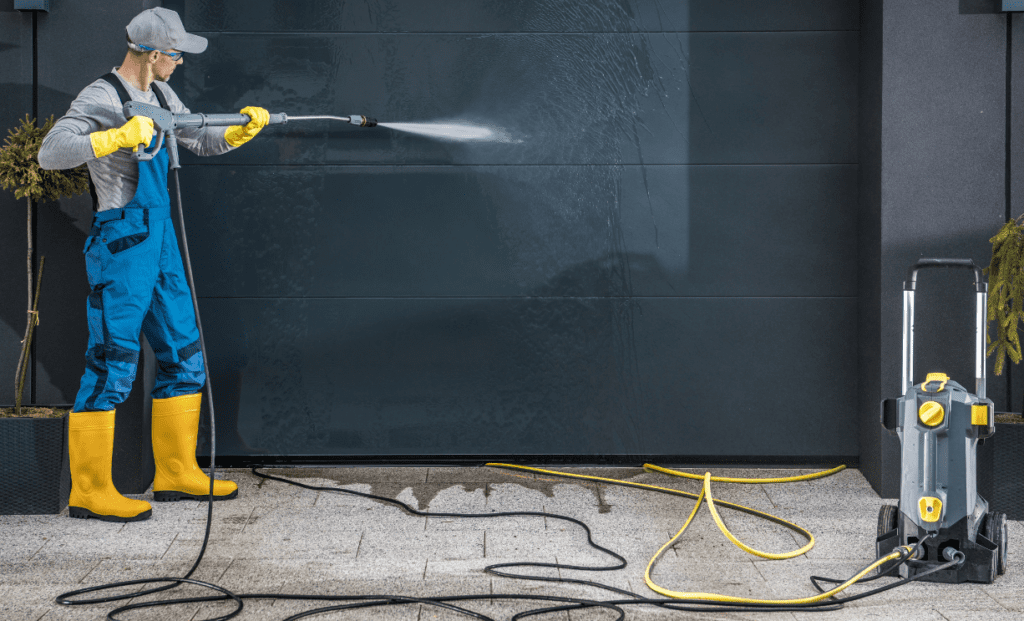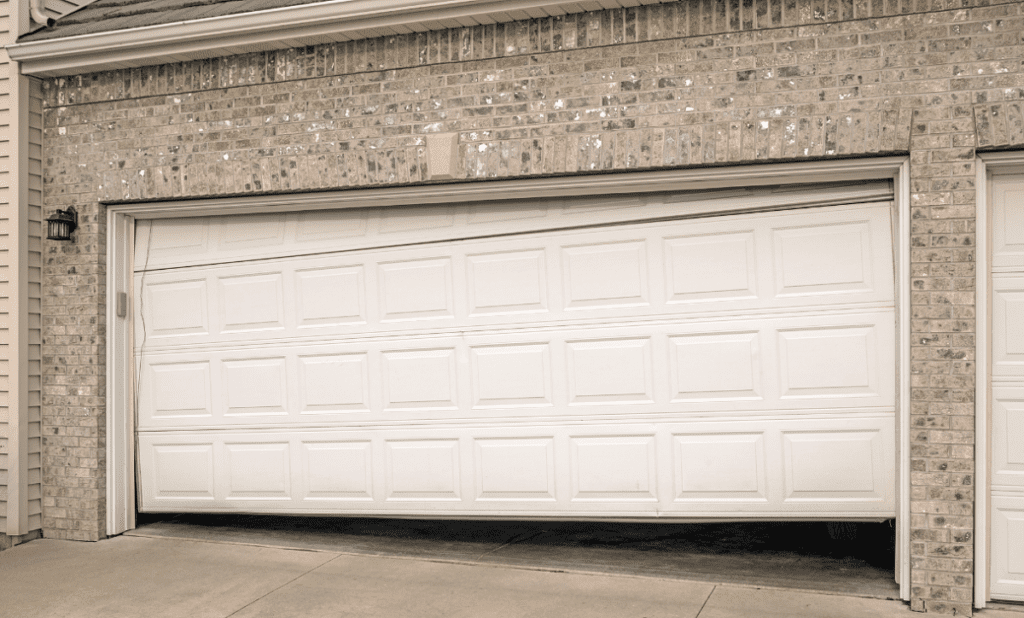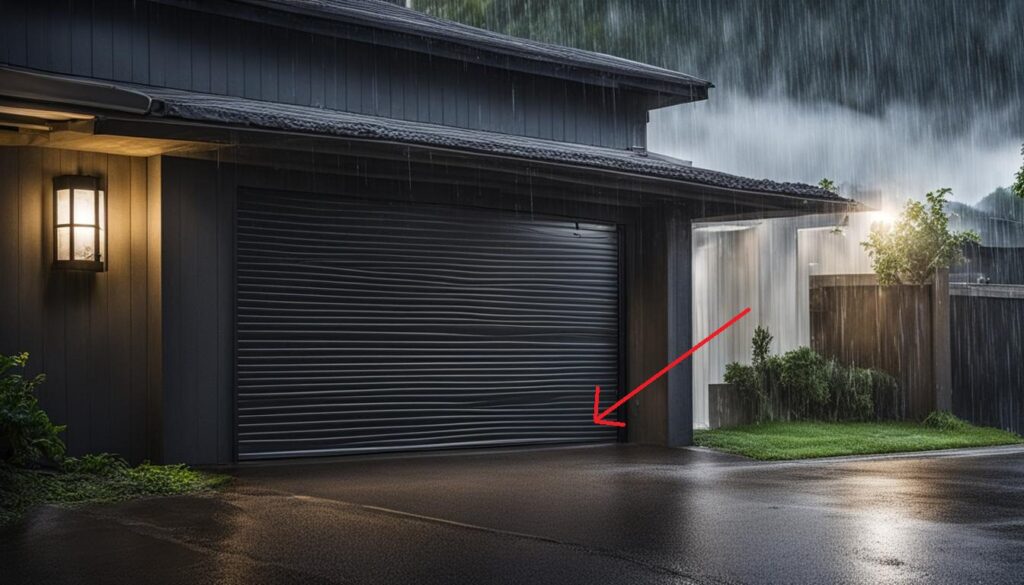
Maintaining garage doors is crucial for preserving the curb appeal of your home. However, as time passes, painted garage doors can start to look dull and faded.
What is the best way to remove paint from painted garage doors? Repainting your garage door might be necessary if you want to give it a new look. But before you can put on a fresh coat of paint, you must remove the old one first.
The Importance of Maintaining Garage Doors
Garage doors are often overlooked when it comes to home maintenance. People tend to forget that they are not only functional but also contribute significantly to the overall appearance of their homes. Neglecting your garage door can lead to severe damage that may require costly repairs or even replacements.
That’s why it’s essential to maintain your garage door regularly, including removing old paint from its surface. Doing so will keep it looking new and vibrant for longer and help prevent issues like rotting or rusting.
Common Problem: Removing Paint from Painted Garage Doors
Removing old paint from a garage door is no easy task. It requires time, effort, and patience—three things most homeowners don’t have in abundance.
Plus, there’s always the risk of damaging the surface while trying to remove paint using improper techniques or tools for garage door paint removal. So what should you do?
What is the best way to remove paint from painted garage doors?
There are various ways you can strip off old paint from a garage door’s surface effectively. They include using chemical strippers, heat guns, sanding, and pressure washing. Each method has its advantages and disadvantages and works better for specific situations than others.
In this DIY guide on how to remove old paint from a garage door safely and effectively, we’ll take an in-depth look at these paint-stripping methods and provide helpful tips and precautions to take for each one. Whether you’re looking to repaint your garage door or merely uncover the original garage door by stripping old paint, this guide will be your go-to resource for everything you need to know about garage door paint removal.
High-Level Overview of Paint Removal Methods
Chemical Strippers: Stripping Paint Off Garage Doors
Chemical paint strippers for garage doors are one of the easiest and quickest ways to remove paint from your garage doors. They work by dissolving the paint, making it easy to scrape off.
When using chemical strippers, however, you need to be very careful. The chemicals used in these strippers can be harmful if not handled with care.
To safely remove paint from a garage door using a chemical stripper, start by cleaning the surface of the door thoroughly. Apply the stripper evenly across the surface using a brush or roller and wait for it to work its magic.
This usually takes around 30 minutes, but some products may take longer. Once done, use a scraper or wire brush to scrape off the old paint.
Heat Guns: Quick Fixes for Garage Door Paint Removal
Heat guns are another popular option for removing old paint from garage doors. They are especially useful when you need to remove small patches of paint or repaint only a portion of your garage door surface.
Heat guns work by melting the old paint, making it easier to scrape off. While heat guns can be effective at removing old paint quickly and easily, they do have their drawbacks.
For one thing, they can be dangerous if not used properly – applying too much heat can cause fires or even melt certain types of garage door materials. Additionally, there is also a risk of inhaling fumes from melted plastic coatings.
Sanding: Effective Techniques for Garage Door Paint Removal
Sanding is another effective way to get rid of old paint from your garage doors – particularly if you have an uneven surface that requires smoothing out before repainting your garage door. One drawback is that it is often slow and laborious work that may require renting specialty equipment. To prevent damaging your garage door surface when sanding, start with a coarse grit sandpaper and slowly work your way up to the finer grits.
Apply even pressure and keep the sandpaper constantly moving to avoid creating uneven patches. Remember to wear protective gear like safety glasses and masks as well.
Pressure Washing: Power Cleaning for Garage Doors
Pressure washing is a great option for removing paint if you want a fast, powerful cleaning solution. It is especially effective at getting into crevices and other hard-to-reach areas of your garage door surface. However, like with the other methods mentioned above, there are precautions that need to be taken.
- To use a pressure washer safely on your garage doors, start by testing it on an inconspicuous spot of the door before using it on the entire surface.
- Adjust the pressure accordingly based on what type of material your garage door is made out of – hardwoods may require lower pressures, while aluminum or steel may be able to handle higher settings.
- Use attachments like rotating nozzles or fan sprays to get into tight spots without damaging any part of your garage door surface.
Removing old paint from garage doors can be challenging but rewarding work if done properly. While there are several different methods that can be used in this process (chemical strippers, heat guns, sanding, and pressure washing), each has its own set of pros and cons that must be evaluated when choosing which method you will use in your specific situation. Always take all necessary precautions for removing paint from garage doors before beginning any project in order to achieve optimal results while keeping yourself safe at all times
Chemical Strippers: Types of Strippers Available in the Market
Garage Door Paint Stripping Methods
When it comes to removing old paint from your garage door, chemical strippers can be a lifesaver. These products work by breaking down the bond between the paint and the surface, making it easier to scrape away. However, not all chemical strippers are created equal, and choosing the wrong one can lead to frustration and wasted time.
There are three main types of chemical strippers available on the market: solvent-based, caustic, and biochemical.
- Solvent-based strippers work well on oil-based paints but may not be as effective on other types.
- Caustic strippers are great for removing multiple layers of paint but can cause damage to some surfaces if left on too long.
- Biochemical strippers are a newer type that uses natural ingredients like citrus or soybean oil instead of harsh chemicals.
Precautions for Removing Paint from Garage Doors
While chemical strippers can be effective at removing old paint, they also come with potential health hazards and safety concerns that should not be ignored. Always wear gloves and eye protection when using these products, as they can irritate your skin or eyes. Additionally, make sure you work in a well-ventilated area to reduce fumes exposure.
Heat Guns: Advantages and Disadvantages of UsingHeat Guns for Paint Removal
DIY Methods for Stripping Paint Off Garage Doors
A heat gun is another option you have for removing old paint from your garage door. This tool works by blowing hot air onto the painted surface, which softens up the bond between the surface and the pigment. However, there are both advantages and disadvantages that come with using this method.
One advantage is that a heat gun can save you time compared to other methods like sanding or scraping. It’s also useful for removing paint from hard-to-reach areas.
However, one disadvantage is that you must be careful not to burn the wooden surface of the garage door while using a heat gun. Another disadvantage of using a heat gun is that it produces fumes and can be dangerous if not used properly.
Tips for Using Heat Guns Safely and Effectively
When using a heat gun, make sure to keep it moving at all times so you don’t focus too much on one area for too long. Also, use a scraper or putty knife to remove paint as soon as it softens up without waiting too long, as this can lead to burnt surfaces. Always wear gloves and eye protection when using a heat gun and work in a well-ventilated area.
Sanding: Types of Sandpaper and Grits to Use for Different Types of Paint Removal Jobs
Sanding Techniques for Garage Door Paint Removal
Sanding is another option for removing old paint from your garage door, but it requires more effort than other methods like chemical strippers or heat guns. The process involves sanding away layers of old paint until the surface is smooth enough for repainting. Different grits of sandpaper are available to make the job easier and less time-consuming.
Using a coarse grit like 60 or 80 will help remove most of the stubborn layers quickly but can leave visible scratches on the surface. A medium grit like 120 is ideal for smoothing out those scratches before transitioning into fine-grit sandpaper such as 220 or higher, which will create an almost polished finish on your garage doors.
Best Practices for Removing Paint from Garage Doors
When sanding your garage door, always wear protective gloves and eyewear goggles because tiny particles may fly around during the process that could irritate or damage your eyes and skin. Additionally, it is important to work in a well-ventilated area to avoid breathing toxic dust particles that could be harmful. Before starting the sanding process, remove any loose paint and debris with a scraper or putty knife so that you have a smooth surface to work from.
Rarely Known Small Details on Paint Removal Methods
Chemical Strippers: The Devil in the Details
The most common mistake people make when using chemical paint strippers for garage doors is not waiting long enough before scraping off the stripper. Patience is key when it comes to this method. Many people scrape off the stripper too soon, which leads to a messy and ineffective removal process.
Make sure to follow the manufacturer’s instructions carefully and wait until the paint starts bubbling up before you scrape it off. Another issue with chemical strippers is how to dispose of them safely.
Chemical paint strippers for garage doors are often toxic and can have disastrous effects on both human health and the environment if not disposed of properly. Follow your local regulations for disposing of hazardous waste, or contact a disposal company if you are unsure.
Heat Guns: Not as Safe as You Think
Using heat guns to remove old paint from your garage door can be effective, but it can also easily damage certain types of garage door materials. Metal and wood are usually safe, but vinyl or plastic materials could melt or crack under high heat.
Always test a small section first before committing to using a heat gun on your entire garage door. Another aspect that is often overlooked is how long it actually takes for a heat gun to soften up old paint.
Many people assume that simply waving the heat gun back and forth will eventually melt away all the layers of paint, but this couldn’t be further from the truth! Depending on how many layers of paint there are, it could take several minutes or even hours until the old paint becomes pliable enough to scrape off.
Sanding: The Messy Middle Child
Sanding may be one of the most popular DIY methods for stripping paint off garage doors, but cleaning up after sanding can be quite challenging. The dust and debris created during the sanding process can spread to other areas of your garage and even your home, so be prepared to take extra precautions, such as sealing off the area or wearing a mask.
When it comes to how much pressure should be applied while sanding, it really depends on the type of paint you are trying to remove and the material of your garage door. Generally speaking, start with a low grit sandpaper and gradually increase the pressure until you find a level that removes the paint without causing damage.
Pressure Washing: The Power Play
Pressure washing is one of the most effective ways to strip paint from your garage door, but there are some important things to keep in mind for safety reasons. The ideal distance between the nozzle and the surface while pressure washing should be around 6-10 inches away from the garage door surface. Any closer than that could cause damage or injury.
Additionally, when it comes to PSI (pounds per square inch), make sure you use an appropriate level for effective cleaning without causing any damage. Most experts recommend using a PSI between 1,500 and 2,000 for effective cleaning.
Frequently Asked Questions
How do you remove paint from a painted door?
To remove paint from a painted door, you can start by using a scraper or putty knife to gently scrape off the loose or flaking paint. Then, apply a chemical paint stripper or paint remover to the remaining paint, following the product instructions. Finally, use a scrub brush or steel wool to remove the softened paint, and wipe down the door with a clean cloth.
How do you remove paint from painted metal?
When removing paint from painted metal surfaces, such as metal doors, you can begin by sanding the surface with medium-grit sandpaper to roughen it up. Next, apply a chemical paint stripper specifically designed for metal, allowing it to sit and soften the paint. Finally, use a scraper or wire brush to remove the paint and clean the metal surface with a suitable solvent or detergent.
What is the best way to remove spray paint from the garage door?
The best way to remove spray paint from a garage door is to first try using a pressure washer with a detergent or paint remover specifically formulated for spray paint. Alternatively, you can use a chemical graffiti remover or rubbing alcohol on a clean cloth to gently scrub away the paint. Always test any product in a small, inconspicuous area before applying it to the entire surface.
How do you remove paint without damaging paint?
To remove paint without damaging the underlying paint, you can try using a mild solvent or paint remover specifically designed for the type of paint you are working with. Apply a small amount to a clean cloth and gently rub the painted surface, testing it in a small area first. Alternatively, you can use a heat gun or a steamer to soften the paint, making it easier to scrape off.
What is the fastest way to remove paint?
The fastest way to remove paint depends on the situation and the type of paint involved. However, using a chemical paint stripper or remover is generally one of the quickest methods. Make sure to choose a product suitable for the specific type of paint and follow the instructions carefully to achieve efficient paint removal.
What is the most effective way to remove paint?
The most effective way to remove paint will vary depending on factors such as the type of paint, the surface material, and the tools or products available. However, a combination of methods often proves effective, such as using a chemical paint stripper or remover, followed by scraping and sanding the remaining paint. Experimenting with different techniques and products may be necessary for the best results.
Conclusion
There are many different garage door paint stripping methods available on the market today. Each method has its own advantages and disadvantages when it comes to safety, effectiveness, and speed.
Before deciding on which method is best suited for your particular situation, we recommend doing thorough research into each option so you can make an informed decision. Remember that prepping a garage door for repainting requires careful planning and execution in order to avoid costly mistakes or risks to personal health or property damage.
DIY guide to paint removal for garage doors requires taking proper precautions, such as wearing gloves and eye protection when handling chemicals or tools. Overall though, with these safety tips for removing paint from garage doors anyone can safely remove old paint from their door without fear!






